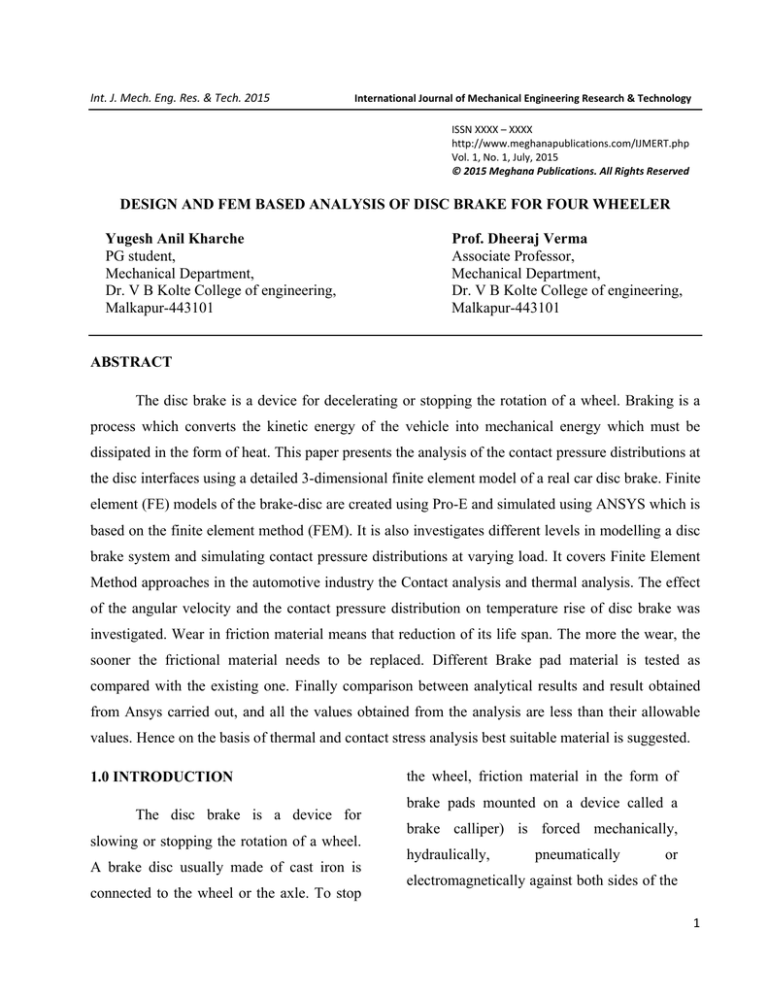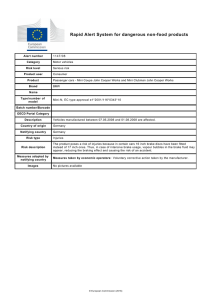
Int. J. Mech. Eng. Res. & Tech. 2015
International Journal of Mechanical Engineering Research & Technology ISSN XXXX – XXXX http://www.meghanapublications.com/IJMERT.php Vol. 1, No. 1, July, 2015 © 2015 Meghana Publications. All Rights Reserved DESIGN AND FEM BASED ANALYSIS OF DISC BRAKE FOR FOUR WHEELER
Yugesh Anil Kharche
PG student,
Mechanical Department,
Dr. V B Kolte College of engineering,
Malkapur-443101
Prof. Dheeraj Verma
Associate Professor,
Mechanical Department,
Dr. V B Kolte College of engineering,
Malkapur-443101
ABSTRACT
The disc brake is a device for decelerating or stopping the rotation of a wheel. Braking is a
process which converts the kinetic energy of the vehicle into mechanical energy which must be
dissipated in the form of heat. This paper presents the analysis of the contact pressure distributions at
the disc interfaces using a detailed 3-dimensional finite element model of a real car disc brake. Finite
element (FE) models of the brake-disc are created using Pro-E and simulated using ANSYS which is
based on the finite element method (FEM). It is also investigates different levels in modelling a disc
brake system and simulating contact pressure distributions at varying load. It covers Finite Element
Method approaches in the automotive industry the Contact analysis and thermal analysis. The effect
of the angular velocity and the contact pressure distribution on temperature rise of disc brake was
investigated. Wear in friction material means that reduction of its life span. The more the wear, the
sooner the frictional material needs to be replaced. Different Brake pad material is tested as
compared with the existing one. Finally comparison between analytical results and result obtained
from Ansys carried out, and all the values obtained from the analysis are less than their allowable
values. Hence on the basis of thermal and contact stress analysis best suitable material is suggested.
1.0 INTRODUCTION
The disc brake is a device for
slowing or stopping the rotation of a wheel.
A brake disc usually made of cast iron is
connected to the wheel or the axle. To stop
the wheel, friction material in the form of
brake pads mounted on a device called a
brake calliper) is forced mechanically,
hydraulically,
pneumatically
or
electromagnetically against both sides of the
1 disc. Friction causes the disc and attached
the car on all moving stages including
wheel to slow or stop. Brakes (both disc and
during high speed, sharp cornering and
drum) convert friction to heat, but if the
downhill movements. The ability to bring a
brakes get too hot, they will cease to work
vehicle safe controlled stop is absolutely
because they cannot dissipate enough heat
essential in preventing accidental vehicle
Today, most passenger vehicles are
fitted with disc brake systems. A disc brake
system typically consists of two pads, a
calliper, a disc, a piston, a carrier bracket
and two guide pins. One of the major
requirements of the calliper is to press pads
against the disc and it should ideally achieve
as uniform interface pressure as possible.
Repetitive braking action rise in temperature
due to friction and brake pad life shorten.
This might lead to dissatisfaction to the
customers who need to visit their garage
more frequently in order to replace wear
brake pads.
The friction heat generated between
two sliding bodies causes deformation
which
alters
the
contact
pressure
distribution. The sliding contact of the
members of disc brake results in kinetic
energy conversion into heat at the pad/disc
interface. The increase of friction moment is
a limited quantity and depends on the
coefficient of friction, radius of rubbing
path, and forces that act on the pads. The
braking system is very crucial in stopping
damage and personal injury. The aim of the
project is to show how to perform a
crashworthiness
simulation
in
the
automobile industry using Finite Element
Method. The effect of the angular velocity
and the contact pressure distribution on
temperature rise of disc brake pad was
investigated.
Finite
element
model
is
prepared and analysis is done with the help
ansys software. Different material is to be
tested so as to compare the existing brake
lining material with the other brake lining
material and suggest the new brake linear
material for the present application.
The customer needs to be visited in
garage more frequently for the replacement
of the brake pad because the existing brake
pad wear. Once the brake pad wears up to
certain limit it reduces its efficiency. The
customer has to apply more brake power for
same braking application. Once the braking
efficiency reduces, it is not safe for the both
passenger vehicle and the other vehicle on
the road. And also the replacement for the
new break pad is more time consuming. This
added the more labour cost for the customer.
2 brake discs are attributed to high
My work is to suggest the new brake
temperatures.
pad material which is having more life than
the existing brake pad material by keeping
•
the existing dimensions same.
As the brake liner frictional material
wears it needs to be replaced every
time due to heat generation and
friction.
•
2.0 OBJECTIVE OF WORK
more bodies in frictional contact
Following are the project objectives:• To study & simulate Disc brake
assembly.
• To
Wear can take place when two or
slide against each other. Wear in
friction
material
means
that
reduction of its life span.
prepare
FEM
MODEL
for
Contact Analysis.
3.0 PART DESCRIPTION
During the braking process the brake
• To compare static contact pressure
pad and brake disc are come in frictional
contact. The exact design and dimensions
distributions for varying conditions.
are taken from the Jaika Motors Limited,
• To suggest the new brake linear
frictional material.
MIDC Hingana. The figure shows the image
of the brake disc and pad. The existing
material properties of cast iron and brake
2.1 PROBLEM DEFINITION
pad as shown in table below.
•
The aim of the project is to show
how to perform a crash worthiness
simulation in the automobile industry
using Finite Element Method.
•
Repetitive braking of the vehicle
leads to heat generation during each
braking
event
causes
rise
Figure 3.1: Modeling of brake Disc
in
temperatures which will affect the
performance of the braking system.
•
Problems such as premature wear of
brake pads and thermal cracking of
3 Figure 3.2: Modeling of brake pad
Table 3.1: material properties of rotor and existing pad
Cast Iron (DISC)
Existing pad
Density
7.4 g/cm3
2.58 g/cm3
Young's modulus (E)
130 Gpa
72.9Gpa
0.27
0.22
Thermal conductivity
55 W/mK
1.3 W/mK
Specific Heat
447 J/KgK
810 J/KgK
10e-6 /K
5.4e-6 /K
Properties
Poisson's ratio
Coefficient of thermal
expansion
4.0 RESULTS
Table 4.1 Result showing comparison of all material tested in ANSYS
Pressure
Analysis
Ceramic
S2 Glass Fibre
Kelvar
Existing
Material
Total
Deformation
1.2758e-005 m
2.0203e-004 m
2.1985e-004 m
2.4329e-004 m
Equivalent
Stress
4.5067e+006 Pa 8.6348e+006 Pa 4.8877e+006 Pa 4.9054e+006 Pa
Strain Energy
Lost
4.16e-006 J
6.8822e-005 J
3.7429e-005 J
4.1476e-005 J
Total Energy
Lost
7.9009e-003 J
7.1267e-002 J
8.6254e-002 J
9.5078e-002 J
4 Thermal
Analysis
Temperature
Distribution
21.876 °C
19.787 °C
22.011 °C
22.011 °C
Total Heat Flux
8.3745e+006
W/m²
6.1966e+006
W/m²
6.414e+006
W/m²
6.4384e+006
W/m²
4.1 Finite element Mesh
Table 4.2 Meshing setting
Physics Preference Mechanical
Relevance
0
Advanced
Relevance Center
Fine
Element Size Default
Smoothing
Low
Transition
Fast
Statistics
Nodes 19054
Elements
8250
FIGURE 4.2 Input boundary conditions
The results of pressure and thermal
analysis shows that ceramic is best suitable
among all other materials and hence can be
predicted as suitable material for brake pads
and liners.
5.0 REFERENCES
[1] Ting-Long Ho., 1974. “Effect of
Figure 4. 1 Meshed body
4.2 Pressure Analysis
frictional heating on brake materials”, Wear,
30(1974) 73-91
[2] Masahiro Kubota., 2000. “Development
of lightweight brake disc rotor: A design
approach for achieving an optimum thermal,
vibration and weight balance.” JASE review
21 (2000) 349-355
5 [3] Mohammed Abdul Majid, “Transient
Madanapalle Institute of Technology &
Thermal Analysis of Materials for Disc
Science, Madanapalle. Andhra Pradesh.,
Brake of a Light-
INDIA Aug-2014
Deccan
College
Weight Aircraft”,
of
Engineering
and
Technology Hyderabad, IJERT Vol. 3 Issue
4, India April-2014
[4] Ziad, 2009. “An investigation of disc
brakerotor
by
FEA.”ISSN:
1985-3157,
Vol.3, No. 2, July-Dec 2009
[5] Sandip B. Phadke, “Automotive Brake
Disc Design to Suppress High Frequency
Brake Squeal Noise”, AISSMS College of
Engineering, Pune
[6] S Naveen Kumar, “Redesign of Disc
Brake Assembly with Lighter Material”,
Computer
Integrated
Manufacturing,
Dayananda Sagar Collegar of Engineering,
Bangalore
[7] Bu-Byoung Kang, Kang-Youn Choe,
Hyeong-Jin Kim. “Braking Performance of
Ceramic Coated Discs”: Korea Railroad
Research Institute
[8] Mostafa M. Makrahy , “Optimization of
a New Wedge Disc Brake Using Taguchi
Approach”, Automotive and Tractor Eng.
Dept.,
College
University,
of
El-Minia
Engineering,
–
61111,
Minia
Egypt,
IJMER, Vol. 3, Issue. 6, Nov - Dec. 2013
pp-3461-3465
[9] G.Ranjith Kumar, “Design Analysis &
Optimization of an Automotive Disc Brake”,
6



